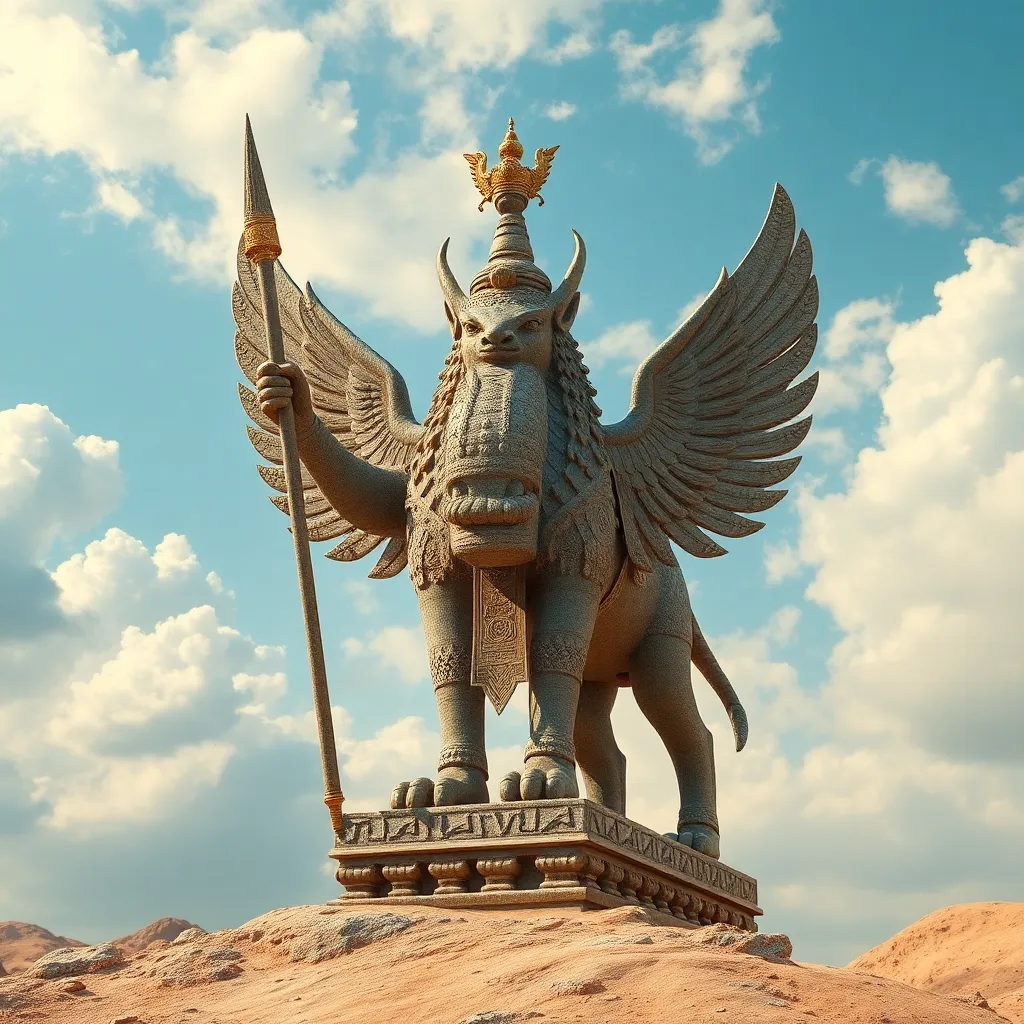The Lamassu in Ancient Persia: Exploring its Role as a Protective Deity
I. Introduction
The Lamassu is a mythological creature that has captivated historians and archaeologists alike due to its rich symbolic significance and intricate artistry. Often depicted as a hybrid being with the body of a bull or lion, wings of an eagle, and a human head, the Lamassu served as a protective deity in ancient cultures, particularly in Mesopotamia and later in Persia.
In the context of Ancient Persia, the Lamassu played a vital role in the architectural and cultural landscape. As a symbol of strength and protection, it was prominently featured in various structures, serving not only as guardians but also as representations of the power and divine favor of the rulers. This article aims to explore the historical significance, physical characteristics, and cultural impact of the Lamassu in ancient Persia.
II. Historical Background of the Lamassu
A. Origins and development of the Lamassu in Mesopotamian culture
The Lamassu traces its origins back to the ancient Mesopotamian civilizations, particularly the Assyrian and Babylonian empires. Initially, it was believed to be a protective spirit that safeguarded palaces and temples, often depicted at the entrances of these significant buildings. The Lamassu was thought to ward off evil and protect the inhabitants from harm.
B. Transition and adaptation into Persian art and architecture
As the Persian Empire rose to prominence, it adopted many elements from the cultures it conquered, including the Lamassu. The Persians integrated this creature into their own artistic and architectural traditions, often amplifying its grandeur and significance. This adaptation signified a blend of cultural influences that characterized the Persian Empire.
C. Historical significance in the context of ancient empires
The Lamassu not only served a decorative purpose but also symbolized the might of the rulers. Its presence in monumental architecture underscored the idea of divine protection over the empire, reinforcing the political and religious authority of the kings.
III. Physical Characteristics of the Lamassu
A. Description of the Lamassu’s design and symbolism
The Lamassu is characterized by its unique and imposing design. It typically features:
- A human head, representing intelligence and wisdom.
- The body of a lion or bull, symbolizing strength and stability.
- Wings of an eagle, indicating swiftness and a connection to the divine.
This combination of animal and human traits was intended to convey a sense of power and guardianship.
B. Analysis of artistic techniques used in Lamassu sculptures
The artistry of Lamassu sculptures is remarkable, often showcasing intricate carvings and detailed embellishments. Artists employed techniques such as:
- Bas-relief carving to create depth and texture.
- Use of color to enhance visibility and impact.
- Precision in proportion to create a sense of realism.
These techniques contributed to the awe-inspiring presence of the Lamassu in ancient architecture.
C. Variations in representation across different regions
While the Lamassu is primarily associated with Assyrian and Persian cultures, its representation varied across regions. In Assyrian art, the Lamassu was often depicted in a more fierce and aggressive posture, whereas in Persian art, it was portrayed with a more serene and majestic demeanor, reflecting the values of each culture.
IV. The Lamassu as a Protective Deity
A. Role of the Lamassu in ancient Persian religion and mythology
In ancient Persian religion, the Lamassu was revered as a guardian spirit. Its role extended beyond mere protection; it was also seen as a mediator between the divine and the earthly realm. The presence of the Lamassu in sacred spaces underscored the belief in its protective capabilities.
B. Symbolism of protection and power associated with the Lamassu
The Lamassu symbolized both protection and the power of the empire. It was believed that the Lamassu could repel evil spirits and misfortune, providing safety to the inhabitants of the land. This dual symbolism reinforced the connection between the divine and the political authority of Persian kings.
C. Rituals and practices surrounding the Lamassu in ancient Persia
Various rituals were performed to honor the Lamassu. These included:
- Offerings of food and incense at the feet of Lamassu sculptures.
- Prayers and invocations seeking protection and favor.
- Festivals celebrating the divine attributes of the Lamassu.
Such practices highlighted the importance of the Lamassu in the spiritual life of ancient Persians.
V. Architectural Significance of the Lamassu
A. The placement of Lamassu in palaces and temples
Lamassu sculptures were strategically placed at the entrances of palaces, temples, and important buildings. This placement was intentional, as it was believed that the Lamassu would protect the space from intruders and malevolent forces.
B. Impact on architectural design and urban planning
The presence of the Lamassu influenced architectural design in several ways:
- Design of grand entrances to signify importance.
- Use of monumental structures to showcase the power of the empire.
- Incorporation of symbolic elements into urban planning.
These factors contributed to the grandeur of Persian architecture.
C. Comparison with other protective figures in different cultures
The Lamassu has parallels in other cultures, such as the Sphinx in Egypt and the Chinese guardian lions. Each of these protective figures serves a similar purpose of guarding sacred spaces and symbolizing strength, yet they reflect the unique cultural values of their respective societies.
VI. The Lamassu in Art and Literature
A. Representations of the Lamassu in Persian literature and art
The Lamassu has been depicted in various forms of Persian literature and art. It appears in poetry, where it symbolizes strength and protection, and in visual art, where its image conveys the might of the Persian Empire.
B. Influence on later artistic movements and modern interpretations
The Lamassu has inspired artists throughout history, influencing movements such as Romanticism and Modernism. Its powerful imagery continues to resonate in contemporary art and design, often used as a metaphor for strength and resilience.
C. Symbolism and themes in contemporary references to the Lamassu
In modern contexts, the Lamassu often represents the blending of cultures and the enduring legacy of ancient civilizations. It serves as a reminder of the importance of protecting cultural heritage and history.
VII. Archaeological Discoveries and Modern Interpretations
A. Key archaeological sites featuring Lamassu sculptures
Significant archaeological sites such as the ruins of Nineveh and Persepolis have yielded remarkable Lamassu sculptures. These sites provide insight into the artistic and cultural practices of ancient Persia and Mesopotamia.
B. Insights gained from modern excavations and studies
Modern excavations have uncovered new information about the construction techniques and cultural significance of the Lamassu. Studies reveal how these sculptures were integral to the identity of the empires they represented.
C. The role of Lamassu in contemporary discussions of ancient Persian culture
Today, the Lamassu is a focal point in discussions about ancient Persian culture, art, and religion. It serves as a symbol of the rich heritage and complex history of a civilization that continues to influence modern societies.
VIII. Conclusion
In summary, the Lamassu holds significant cultural and historical importance in ancient Persian society. As a protective deity, it embodied the strength and authority of rulers while safeguarding sacred spaces. Its artistic representation and architectural prominence reflect the values and beliefs of the time.
The enduring legacy of the Lamassu continues to inspire contemporary discussions about ancient civilizations and their protective deities. Understanding the Lamassu not only enriches our knowledge of ancient Persia but also highlights the universal themes of protection and power that resonate throughout history.
Ultimately, the Lamassu stands as a testament to the artistry, spirituality, and cultural achievements of ancient peoples, reminding us of the importance of preserving and understanding our shared heritage.
</



